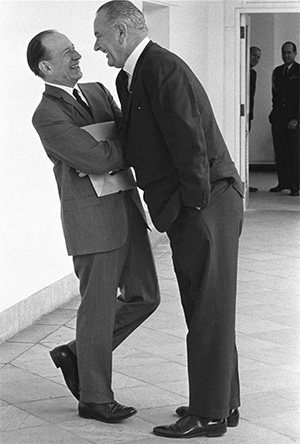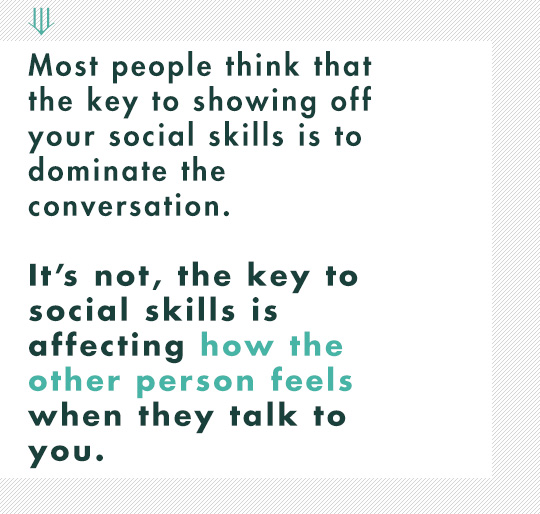Do you ever dread getting the question “Hey what are you doing Saturday night?”
It goes something like this— a friend you really like invites you to a social event, it could be their office’s holiday party or a birthday celebration, but here’s the catch….you won’t know anyone else who will be there.
Your first instinct may be to make up an excuse about how you have to do laundry on Saturday night because you just can’t fathom having to socialize with complete strangers. You can already see it, you’re standing on the peripheries of the party playing with your phone while everyone else is laughing and having a great time with each other.
But admit it…there’s a part of you that would really like to check out that new bar and maybe even meet a cute girl or make new friends.
Well here’s your chance.
Today I’m going to give you a simple 5-step process to meet new people, make friends and get them to love talking to you.
I’ll give you word-for-word scripts to use and teach you how to start conversations that make people feel special, a strategy to get people to subconsciously find you charismatic and what you should be talking about when meeting new people.
Step #1: Take Initiative by Introducing Yourself
Alright so you walk into a social event and you only know the host. For starters, here’s one thing to NOT do — be a clinger.
Just because you only know the host does not give you an excuse to attach yourself to them the entire night. They have a lot of responsibilities and obligations to make sure everything is going smoothly. It’s a party…socialize!
But how?!
Take advantage of being a stranger. Since you don’t know anyone there, you have the perfect excuse to introduce yourself to anyone . The good news is that since you all have a friend in common you’ll have an easy conversation starter!
Here are some word-for-word scripts you can use to start a conversation:
- “Hi there, I don’t think we’ve met before. I’m Josh, I know Sam through work. How do you know him?”
- “Hi there, I’m Josh. How long have you known Sam?”
- “Hi there, I’m Josh. Do you know a lot of Sam’s friends that are here tonight?”
- “Hi there, I’m Josh, I know Sam the host, who do you know?”
Here’s why these scripts work:
- You establish common ground – People like people who are like themselves. Research has shown that when people share an interest, they assume that they are like them in other ways (even if they’re not).
- You let the other person go first – By keeping your ice-breakers short, you immediately focus the attention on the other person. People LOVE talking about themselves. By opening the conversation around them, you’re already raking in charisma points.
- You ask open-ended questions – Notice how the questions are somewhat open-ended, they necessitate a longer answer beyond just a “yes” or “no.” Your conversation partner will likely explain that they know Sam through another mutual friend or that they work in the same department, or they’re childhood buds, which may lead to an even longer conversation.
Step #2 Use Body Language that is Approachable
While it’s great to take initiative to meet people, you also want to look approachable.
Although this sounds like common sense, you’d be surprised at how many mean muggers or aloof-looking people I come across at social scenes. The guy consumed with his smartphone, the girl who’s standing alone on the outskirts of the crowd frowning, I could go on and on.
The point is if you’re going to a social event, engage! Whether it's through verbal or nonverbal language, there are ways to show that you’re open to being approached so people can get to know you.
The first and easiest thing you can do is smile.
Smiling is simple and thanks to mirror neurons it gives off positive vibes, literally. You can change people’s emotions by your body language! It’s crazy!
Emotions can be affected by simply observing body language cues from others in the form of facial expressions or body movements. Thanks to mirror neurons, if someone sees you smiling they’ll feel associative emotions like joy and happiness. Think about it, isn’t it pretty hard to not smile back at someone or laugh when a baby is smiling at you?
The other important aspect of smiling is that it also positively affects you, internally. An experiment by Martin and Stepper had subjects put a pen in thour mouths (to simulate a smile) while reading comic books. The other group of subjects read the comic books without the pen in their mouths.
The group with the pen in their mouths and who had a “forced smile” found the comic books more entertaining and enjoyable. This experiment has been validated numerous times across the world. Smiling is universal and makes you feel happy!
Making eye contact and flashing a smile at someone is one of the easiest nonverbal indicators that you are approachable. It “tells” the other person you’re ready to engage. The great thing about being at a party or other social event besides a bar, people go there expecting to chat, be social, and engage with others. No polite, regular person is going to reject a smile in a setting like this.
Step #3: Have Selfless Conversations
One of the easiest ways to get people to fall in love with talking to you is getting them to talk about themselves. “Humans devote 30-40% of speech output solely to informing others about their subjective experiences.”
See, people love talking about themselves, it triggers the same reward centers in their brain that drugs and sex do!
In an interesting experiment, subjects were offered money if they answered questions about other people like President Obama rather than talking about themselves. Even with that offer, subjects were willing to forego the money just so that they could talk about themselves!
Most people think that the key to showing off your social skills is to dominate the conversation. It’s not, the key to social skills is affecting how the other person feels when they talk to you. People remember less of what was said in a conversation and more about how they felt after they spoke to you.
That being said, by taking a genuine interest in the other person you’ll be perceived as likeable and charismatic. Think of every conversation as an opportunity to unlock a mystery about the person you’re interacting with.
One of the best ways to get people talking about themselves is to ask them open-ended questions about themselves like:
- Where are you from? What was it like growing up there?
- What’s your favorite part about your job?
- What’s your favorite thing to do on weekends?
- I just read about [insert current event here] what’s your take on it?
- Where’s the next place you want to travel to?
Another key question that can act as your “go to” when you don’t know what to say or where to take the conversation is “why?” It’s one of the most underrated questions you can ask.
For example, if someone shares that they work for an architecture firm for a living but they don’t really like their job, you can ask why.
They may go on to tell you about their real passion which is rock climbing and that if they had it their way they’d photograph mountains and go rock climbing every day of their lives. Ta-da! You’ve just surfaced their passion and you’re both talking about it.
There’s another reason to be selfless – and it’s actually selfish. When you focus on the other person and are not obsessed with yourself, you become less anxious.
“In a review of more than 200 studies, researchers concluded that the more self-focused we are, the more anxious— and depressed and negative— we become. Self-focus also makes us more sensitive to physical difficulties.” [ Source. ]
So the next time you begin thinking self-consciously, realize that being focused on the other person will get you much further than being concerned with yourself.
Step 4: Use Body Language Effectively
Your nonverbal cues express what you’re thinking and can affect other people’s perceptions of you. It’s one of those things that people constantly ignore because they’re so concerned with what to say in a conversation. But people also “read” your body language.
Here are a few body language tips:
- Stand strategically – When you’re speaking or approaching someone, stand at a 45 degree angle from them so you’re a bit off to the side. Standing square in front of the other person could be intimidating. If you’re angled to the crowd, it will also feel more inviting to others.
- “Open” body language – Don’t cross your legs or arms.
- Eye contact – Maintain eye contact while talking to the other person. If you find maintaining eye contact difficult, try looking at your conversation partner’s eyebrow or focus on one of their eyes
Finally, here are body language no-no’s:
- Do not play with your phone – Isn’t it super annoying when someone you’re speaking with is obsessed with their phone while speaking with you? Don’t be that guy.
- Do not look around – Although you may be at a fun bar or event, keep your eyes and attention fixed to the person you’re speaking with. Giving your undivided attention to your conversation partner will make them feel like you’re engaged with what they’re saying and not just being polite. Remember, making someone feel like they’re the only person in the room that matters is the secret to being charismatic.
- Do not stand too close – Don’t be a close-talker. Make sure that there’s enough space between you and your conversation partner. As a rule of thumb, if you’re standing at a 45 degree angle from the person and put your hand on your hip your elbow shouldn’t make contact with their body
Step #5: Use Mirroring to be Charismatic
I want to let you in on an advanced body language strategy that can get people loving you on a subconscious level. It’s called mirroring, in scientific lingo it’s called “limbic synchrony” and occurs due to mirror neurons, which we discussed earlier.
Put simply, it’s ‘listening' and ‘responding' to people’s body language cues. It’s crossing your arms when they’re crossing theirs, positioning your feet the way their feet are positioned and even incorporating their pace of speech.
Pay attention the next time you have a great conversation, notice how you’re both likely following each others body language cues, it’s hardwired into the human brain thanks to evolution. It’s a natural way to show you’re engaged with someone else.
When you’re speaking with someone you can mirror things like:
- Their body posture – If they’re leaning in or leaning back, you can too. If they’re standing straight and have their chest open, that’s a great posture to assume. Avoid mimicking low-power poses like slumped shoulders.
- Pace of speech – If someone is excited and speaking fast, you can do the same. If they’re speaking slowly, you can do that too.
- Facial expressions – If someone is furrowing their eyebrows and is telling a sad story, you can mimic them to show that you’re empathizing with their story. If they’re having fun and laughing, smile to show that you’re engaged with what they’re saying
When mimicking, don’t be overtly obvious. You’re not trying to repeat every gesture like a real mirror, you’re looking to engage in the same body language they are. If someone changes their body language, give them a few moments before mimicking. Use your best judgement, if someone is changing their body language every few minutes, it’s going to look weird if you’re immediately copying every single cue they make. This is a powerful strategy, so use it wisely and observe it in the wild before using it.
Bonus Step #6: Exchange Contact Information
If you’ve been putting these steps into practice effectively and having a great conversation with someone you’re ready for the bonus step…getting their contact information so you can stay in touch.
Before we get into examples, I want to call something out. While you’re having conversations you will run into instances where you find that you share something in common with the person you’re speaking with. If you can identify some of those things and then use it as a way to keep in touch, you’ll then have a reason to get their contact information. Humans tend to comply with requests when there’s a reason for them .
Here are some word-for-word scripts you can use:
- Kelly, I really enjoyed our conversation. I’m going to head out, but I’d really love to take you to coffee next week so we can chat more. What’s your number?
- Kelly, I really enjoyed our conversation. I have to take off early, but let’s connect on [insert social media site here i.e. Facebook]
- Kelly, there’s this spot by my office that has a great happy hour that some friends and I have been meaning to check out. Would you want to come with us this week?
- John, I know we just met but you seem like a cool guy. Josh and I are grabbing a beer this week, you should come.
- I’m going to [insert cool event here that they showed an interest in a movie, concert] with a couple of the guys here next weekend. I think you’d enjoy it, would you want to join?
The type of contact information you want to get depends on the context. If you want to keep in touch professionally, I’d connect on LinkedIn. If you want to connect socially but feel like getting a phone number would be too familiar, you can connect on a social network.
If you want to keep in close touch with someone or are interested in them romantically, you can ask for their number but unless you’re really vibing I’d stick to a social media connection first.
Conclusion & Free Mini Course
Going to a party can be intimidating but by taking initiative, being approachable, selfless and charismatic you’ll be on your way to go to parties and socialize with ease. Treat every conversation as an opportunity to deeply connect with another human, be interested in them and unlock their mysteries. Finally, it’s all about the follow up so after you get their contact information, keep up the social momentum!
This is a guest post by Katrina Razavi, communication coach and founder of Communication forNerds.com . If you liked this article, visit her site to sign up for a free three-video mini course called: How to Shut Up that Inner Voice & Beat Awkward Conversations. It covers six secrets to social confidence, the #1 strategy to improve your life and how to have natural conversations…even if you’re super awkward.




















